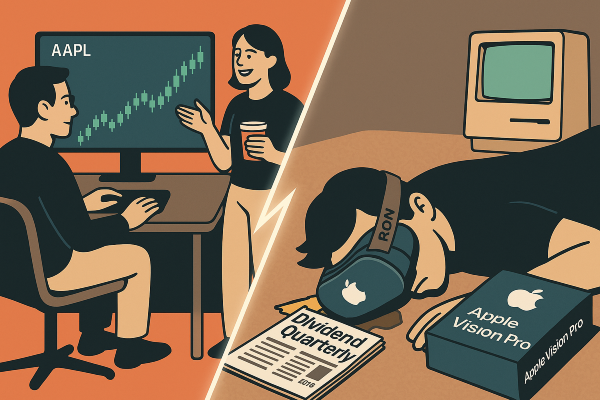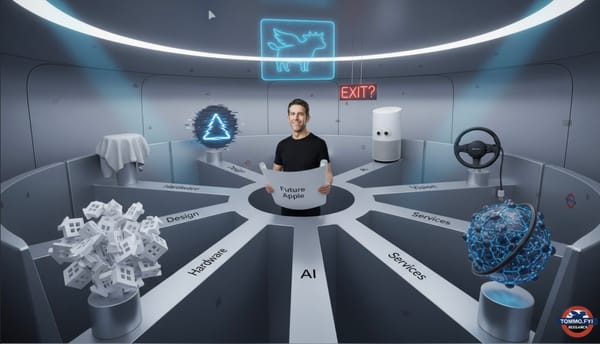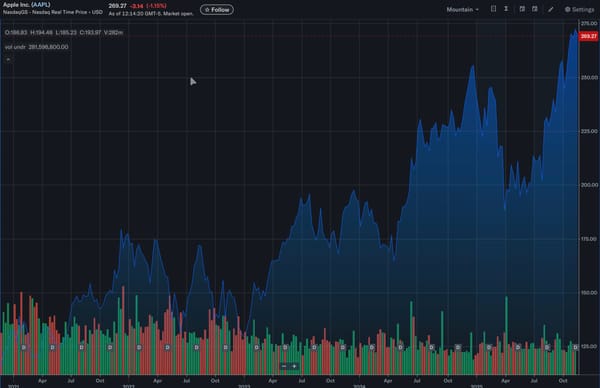Adieu, Farewell, Auf Wiedersehen AVP?
Apple Investors would do better to look at their trading screens, than drool on the floor watching dinosaur movies on their-now redundant bricks with a battery pack attached by a string like a tampon, as they check their insurance for whiplash injuries cover by using ... "spatial computing."

AVP: A Flop in Need of a Redemption Arc (But Don’t Hold Your Breath)
Let’s just get it over with: the Apple Vision Pro flopped. Not quietly, not gracefully, and certainly not privately—despite Apple’s best attempts to wrap the mess in velvet language and reposition it as a “public beta” for “spatial computing.” For $4,000. With a battery dangling like an umbilical cord.
If you think that’s harsh, you’ve clearly been reading the press briefings and not the price chart. Or listened to Ron. Or Joseph.
Because here’s the thing: when your product is known more for dinosaur demos and FaceTime avatars that look like they crawled out of the uncanny valley and got hit by a rake—while the rest of the world is gritting its teeth through inflation, geopolitical instability, and literal proxy wars—then maybe, just maybe, your internal product roadmap needs a rethink.
AVP’s sin isn’t just aesthetic or even functional—it’s chronological. It arrived out of order. In 2016 Apple were looking into AR wearables. Predfictably, mission creep took over, and the influx of engineers and designers from all over the Valley started murmusing about the wonders of a headset priced at $4000 that would do everything except display pornography (which franklly is the only use case for a set of $4000 immersive goggles).
And five years later, The Vision Department was established, to design and launch "Apple's AR and VR vision."
Sadly, there was less vision and more zealotry, which will be a curiously familiar concept to anyone who knows a buyer of the AVP who still insists it was a success, because it might be in the future. I don't think that recursive inverted logic looop deserves reconstruction.
Nobody had the balls to suggest pornograhy might still have rescued the AVP from oblivion and turned it into the biggest CE success since the VHS player.
If you were an Apple insider without vested interest in pretending the emperor has goggles, you’d admit the obvious: the first product should have been Apple Glasses. AR wearables. Lightweight, pass-through, discreet, with a clear consumer use case. Real-time translation, private notifications, wayfinding, real-world productivity overlays—basically, tech with purpose. Something people want to wear, not something they need to justify while hiding in their home office pretending they’re on a space station.
But instead, we got a device born from a hardware org at war with itself. The Vision Pro was Dan Riccio’s internal hail mary after being buried elsewhere at Apple. And it shows. The VisionOS team, originally forged to innovate, was repurposed to triage Siri. AI teams bolted on features like velcro after a toddler meltdown. Internecine warfare bled into every product decision. And it all culminated in a headset so awkward it needed to be renamed mid-cycle just to imply it might be something other than the flop it was rapidly becoming.
The tragedy here isn’t that AVP was a failure. It’s that its failure has now cast a shadow over AR and VR where Apple could have dominated, 5 years ago—where the actual gold mine lies. Apple still has the ecosystem. It still has the design chops (somewhere, hopefully still employed). It could still pull off AR wearables that actually matter. But after Vision Pro, the public won’t just need convincing—they’ll need amnesia.
So what could redeem AVP?
Only two things: either a miraculous re-engineering that strips it down into something cheaper, lighter, and actually wearable—or a bold leap forward with Apple Glasses that resets the narrative completely.
A mass-market AR wearable, unburdened by the ghost of spatial computing. Something that answers a real-world need, not just demos a dinosaur in your living room while the real world burns down outside it.
Until then, AVP remains what it is: a tech demo in search of a reason.
And unless you’re Ron, Joseph, or a shareholder trying to justify a long position with a sunk cost fallacy, it’s time to call it what it is:
A detour, not a destination. A product without a point. A Vision without a future—unless Apple finds the courage to forget it ever happened. A piece of computing, lost in space. Oh! ... "Spatial Computing!" Now I get it!




